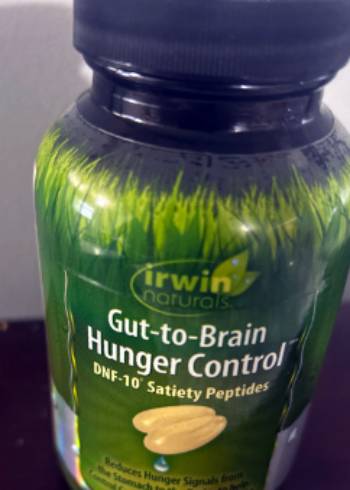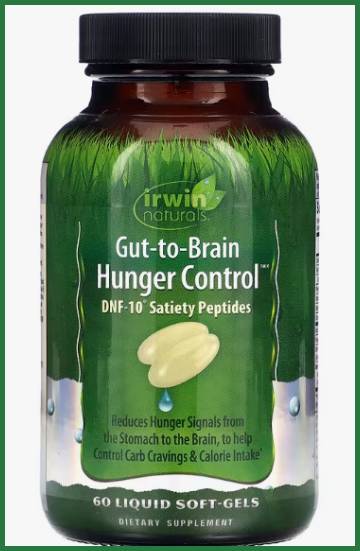If you’ve been searching for a way to tame those relentless carb cravings and curb excessive hunger, Gut to Brain Hunger Control might be the answer you’re looking for.
For anyone who’s struggled with weight management due to constant cravings and calorie-rich foods all around, this product aims to balance things out.
Here, I’ll walk you through my experience with it, what it offers, and everything you should know to get the most out of it.
What is Gut to Brain Hunger Control?

This supplement from Irwin Naturals targets hunger and cravings by addressing communication between your gut and brain, specifically through the hormone ghrelin.
Ghrelin, often called the “hunger hormone,” is responsible for those pesky feelings of hunger that can derail even the most dedicated weight-loss efforts.
The star ingredient, DNF-10® Satiety Peptides, is designed to reduce those signals from your stomach to your brain, helping you feel fuller for longer.
Alongside DNF-10®, this product also contains Chromium, Methylcobalamin (B12), Vitamin B6, and MCTs to support energy and metabolism.
Plus, it comes in liquid soft gels, making it easy to incorporate into a daily routine without any chalky taste or bulky pills to swallow.
How Gut to Brain Hunger Control Stands Out
Gut to Brain Hunger Control is unique in that it’s a non-stimulant formula, making it suitable for those who want to avoid caffeine jitters.
While many other hunger suppressants rely on caffeine to reduce appetite, this formula instead uses natural peptides to affect appetite at the hormonal level.
This not only targets hunger but also helps with the carbohydrate cravings that often sabotage calorie control.
Also Read: My Thoughts On Irwin Stored Fat Belly Burner
My Personal Experience and Results

When I started using this product, I was cautious. I’ve tried my share of hunger-control supplements, and while some have worked temporarily, they often came with unpleasant side effects or wore off too quickly. But Gut to Brain Hunger Control was different. Here’s how it played out for me:
After about a week, I noticed I wasn’t reaching for snacks as much, especially the high-carb, sugary ones I usually crave. By the time lunch rolled around, I felt fuller much faster and even found myself skipping desserts or sugary drinks afterward, which was a surprise. This fullness lasted through the afternoon, making it easier to avoid mindless snacking.
My meals naturally became smaller, and I wasn’t fighting the urge to overeat at every opportunity. It felt like my body was better tuned to tell me, “You’re full. No need for more.” This was a big shift for me, as I tend to snack or eat out of habit rather than true hunger.
Pros & Cons Of Gut to Brain Hunger Control
Pros:
- Reduced Hunger and Carb Cravings: One of the biggest advantages of Gut-to-Brain Hunger Control is its ability to target hunger signals effectively. The DNF-10® Satiety Peptides it contains are specifically designed to influence the hunger hormone, ghrelin, which plays a role in appetite control. Many users report reduced cravings, especially for carbohydrates, which can be a huge help when trying to maintain a calorie deficit.
- Enhanced Portion Control: For those who struggle with portion sizes, Gut-to-Brain Hunger Control offers a solution. Users often find that they feel fuller more quickly, allowing them to eat less without feeling deprived. This can make a significant difference in cutting down calories naturally without constant restraint.
- Convenient Liquid Soft-Gels: The product comes in liquid soft-gel form, which not only makes it easy to swallow but also ensures quicker absorption compared to traditional capsules. This feature is especially useful for those who find other supplement forms uncomfortable or slow to act.
- Supports Energy Balance: Besides DNF-10®, this product contains ingredients like Chromium, Vitamin B12 (Methylcobalamin), Vitamin B6, and Medium-Chain Triglycerides (MCTs). These components help support energy levels, which can be beneficial for anyone cutting back on calories and needing an energy boost throughout the day.
- No Unpleasant Aftertaste: Unlike some supplements, Gut-to-Brain Hunger Control doesn’t leave an unpleasant aftertaste, making it easy to incorporate into a daily routine. It also has no strong odor, which many users appreciate.
Cons:
- Variable Effectiveness: Results with Gut-to-Brain Hunger Control can vary widely from person to person. Some users report noticeable reductions in hunger within days, while others see only mild effects. This variability might be due to individual metabolic differences or lifestyle factors.
- Price Point: Although more affordable than some competitors, Gut-to-Brain Hunger Control might still feel a bit pricey for those on a tight budget, especially considering that it’s intended for long-term use. Some users may feel that similar benefits can be achieved through other, less expensive methods.
- Potential Adjustment Period: Some users report that it takes a few weeks to start experiencing the full effects of the hunger-reducing benefits. This adjustment period may be frustrating for those looking for rapid results, particularly if they are looking to lose weight quickly for an upcoming event or deadline.
- Glass Packaging: While glass containers have their perks, such as reducing plastic waste, they are also more prone to breakage and might not be ideal for travel. Some users wish it came in a more durable, lightweight container for added convenience. Not a Complete Solution: While Gut-to-Brain Hunger Control helps reduce hunger and cravings, it doesn’t guarantee weight loss by itself. Like all weight management aids, it works best when combined with a balanced diet and regular exercise. Users who expect significant results without changing their eating habits may be disappointed.
- No Caffeine Content: For those who like a caffeine boost for energy, this product doesn’t include any stimulants. While it’s beneficial for users who avoid caffeine, others may need to take an additional supplement or consume caffeine separately if they rely on it for daily energy.
Getting the Most Out of Gut to Brain Hunger Control

To maximize the benefits of Gut to Brain Hunger Control, here are some tips based on my experience:
- Pair It with a Balanced Diet: While this product reduces hunger, it’s important to still choose nutritious foods. Eating balanced meals with lean proteins, whole grains, and veggies can complement the effects and help you stay full longer.
- Stay Consistent: Like any supplement, consistency is key. I found the best results came from taking it every day at roughly the same time, allowing my body to adjust gradually.
- Hydrate Well: Sometimes, thirst can masquerade as hunger. Drinking water throughout the day not only helps with hydration but also enhances the fullness effects of the supplement.
- Exercise for Added Metabolism Boost: While Gut to Brain Hunger Control isn’t a workout supplement, light exercise can enhance the metabolic benefits from ingredients like MCTs and Vitamin B6.
- Plan for Patience: This isn’t an instant solution. It’s a product designed for steady, sustainable hunger control, so if you stick with it, you’re more likely to see long-term results.
Gut to Brain Hunger Control Vs. Other Brands
To put things into perspective, here’s how Gut to Brain Hunger Control compares with other hunger-control supplements on the market:
- Gut to Brain Hunger Control Vs. PhenQ
PhenQ is a popular weight loss supplement that includes caffeine as a primary ingredient, which provides an immediate boost to metabolism and energy but can also lead to jitters. Unlike Gut to Brain, it’s not ideal for evening use. While PhenQ works quickly, the stimulant approach might not be suitable for everyone.
- Gut to Brain Hunger Control Vs. Leanbean
Leanbean is marketed mainly toward women and focuses on hormonal support for appetite control. While Leanbean does offer appetite suppression, it doesn’t specifically target ghrelin the way Gut to Brain does. Gut to Brain is, therefore, better suited for those looking for targeted hunger hormone control without a gender-specific formula.
- Gut to Brain Hunger Control Vs. Hydroxycut
Hydroxycut has a strong reputation but is heavily reliant on stimulants, especially caffeine. This makes it more intense and likely to cause energy spikes and crashes. Gut to Brain Hunger Control’s non-stimulant formula is a gentler option without the risk of caffeine overload.
Frequently Asked Questions (FAQ)
The lawsuit against Irwin Naturals involved claims of misleading advertising. The company has since continued to update its products, with many consumers still trusting it for supplements like Gut to Brain Hunger Control.
Many users report positive experiences with Irwin Naturals, especially with products like Gut to Brain Hunger Control that focus on natural, hormone-based hunger control. Results, of course, can vary from person to person.
Irwin Naturals was founded by Klee Irwin, who has established the brand as a go-to for natural wellness supplements.
No single vitamin targets belly fat directly. However, B vitamins, particularly B12, play a role in metabolism, which can support weight loss when combined with diet and exercise.
Final Thoughts
Gut to Brain Hunger Control is a solid choice for anyone wanting a non-stimulant, gentle approach to hunger management. By focusing on ghrelin and satiety peptides, it takes a targeted, natural route to help reduce calorie intake and curb cravings. For me, it has been a valuable tool to keep hunger in check without feeling deprived or overly restricted. If you’re serious about managing your weight sustainably, Gut to Brain Hunger Control might just be the addition your routine has been missing. Give it a try—it could be the step you need to finally regain control over your hunger and cravings.



